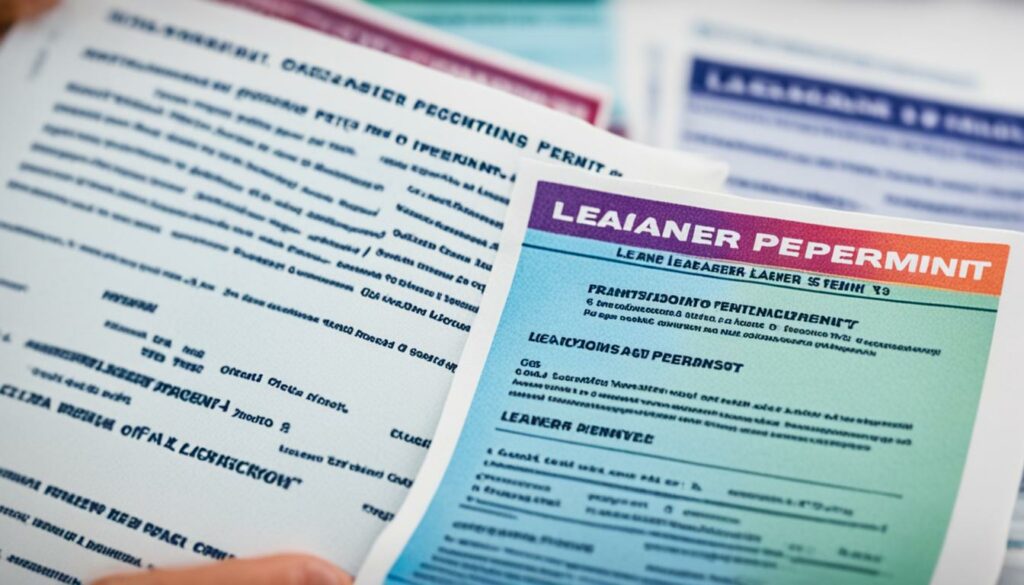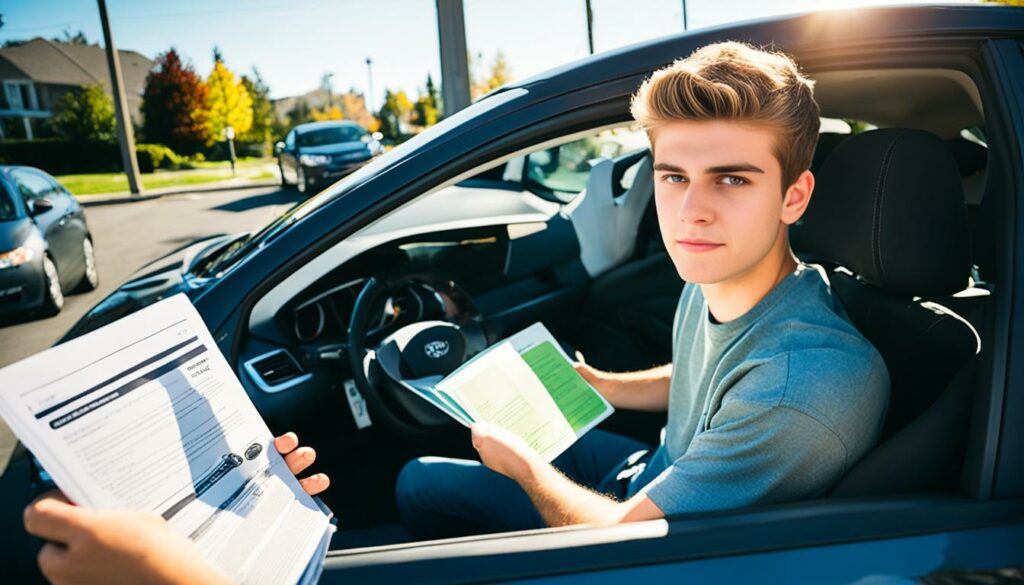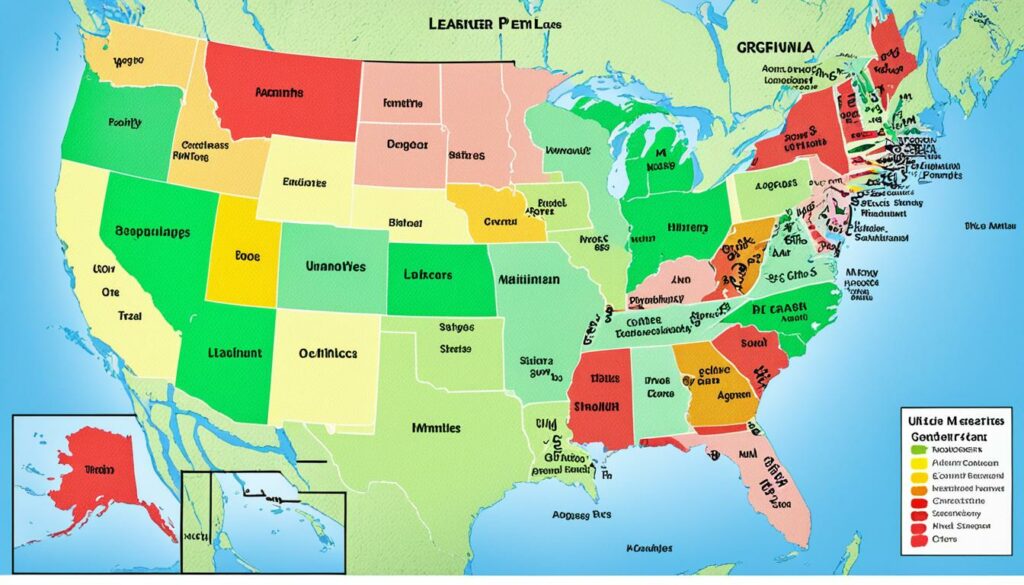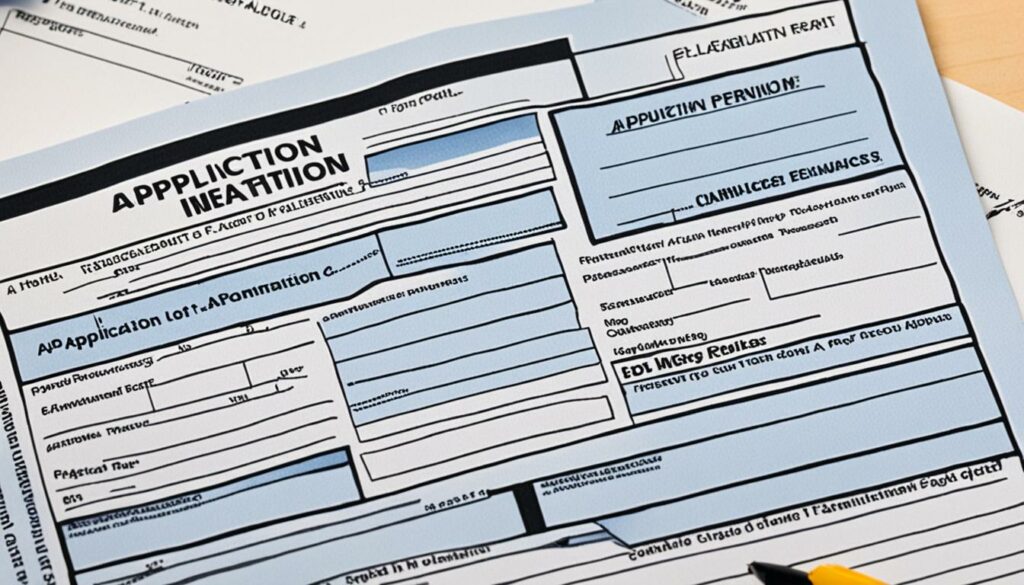Getting Your Driver’s License at 15: How-To Guide
In some states in the US, teenagers as young as 15 years old can obtain their driver’s license. Getting your driver’s license at 15 is an exciting opportunity that comes with its own set of requirements and restrictions. This guide will provide you with all the information you need to know about getting a driver’s license at 15, including eligibility, requirements, and important safety tips to keep in mind.
Key Takeaways:
- Getting a driver’s license at 15 is possible in some states in the US.
- There are specific requirements and restrictions for underage drivers.
- Teenagers should prioritize safety and practice responsible driving habits.
- Parents play a crucial role in teaching their teens to drive safely.
- Knowing how to drive in different conditions is essential for young drivers.
What is a Driver’s Permit?

A driver’s permit, also known as a learner’s permit, learner’s license, or provisional license, is a restricted license that first-time drivers must obtain before getting a full driver’s license. It serves as a stepping stone to gaining the necessary experience and skills needed to become a licensed driver.
A driver’s permit allows individuals to start learning how to drive under specific conditions and with certain restrictions. It is typically issued to teenagers who are not yet eligible for a full driver’s license but are eager to begin the process of becoming responsible drivers. Obtaining a driver’s permit is an important milestone for young individuals as it marks the beginning of their journey towards independence and mobility.
In order to apply for a driver’s permit, aspiring drivers must meet the age requirements set by their respective state. The age to apply for a driver’s permit varies across different states in the United States. Some states allow individuals as young as 14 or 15 to apply for a learner’s permit, while others may require applicants to be at least 16 years old.
It’s worth noting that the process and requirements for obtaining a driver’s permit may differ from state to state. Therefore, it is essential for aspiring drivers to familiarize themselves with the specific regulations and guidelines in their state of residence. This information can typically be found on the official website of the state’s Department of Motor Vehicles (DMV) or similar governing authority.
Acquiring a driver’s permit is an essential first step for individuals who are eager to learn to drive and obtain their full driver’s license. It offers the opportunity to gain valuable experience behind the wheel while being supervised and guided by a licensed adult driver. With a learner’s permit in hand, aspiring drivers can begin honing their skills and knowledge of driving rules and regulations, paving the way for a successful journey towards obtaining a full driver’s license.
How U.S. Teenage Driver Licensing Works

Obtaining a driver’s license as a teenager in the U.S. involves several steps and requirements. It’s important to understand the process to ensure a smooth journey towards getting your license.
Learner’s Permit Basics
Before you can apply for a driver’s license, you will need to obtain a learner’s permit. A learner’s permit allows you to practice driving under the supervision of a licensed adult. The requirements for obtaining a learner’s permit may vary by state, so be sure to check with your local Department of Motor Vehicles (DMV). Generally, you will need to:
- Be a certain age, which can range from 14 to 16 depending on the state
- Complete a driver education or driver training course
- Pass a written knowledge test
Once you have your learner’s permit, you can start practicing driving with a licensed adult in the car.
Preparing for the Permit Test
One of the key steps towards obtaining a learner’s permit is passing the written knowledge test. This test assesses your understanding of traffic laws, road signs, and safe driving practices. To prepare for the permit test:
- Study the driver’s handbook provided by your state DMV
- Take practice tests online or through mobile apps to familiarize yourself with the types of questions that may be asked
- Review any specific rules or regulations unique to your state
By dedicating time to studying and practicing, you’ll increase your chances of passing the permit test.
Learner’s Permit Restrictions
While driving with a learner’s permit, there are typically certain restrictions that you must follow. These restrictions may include:
- Driving only with a licensed adult in the car
- Limitations on nighttime driving
- Prohibitions on driving with passengers who are not immediate family members
It’s essential to adhere to these restrictions to ensure your safety and the safety of others on the road.
| State | Learner’s Permit Age |
|---|---|
| California | 15 1/2 |
| Texas | 15 |
| New York | 16 |
| Florida | 15 |
| Ohio | 15 1/2 |
Learner’s Permit Age By State

One of the key factors in obtaining a learner’s permit is the minimum age requirement set by each state. The learner’s permit age can vary across the United States, with some states allowing 14-year-olds to apply, while others requiring applicants to be at least 16 years old. It’s crucial for aspiring drivers and their families to be aware of the specific requirements in their state to ensure compliance and a smooth application process.
Here is an overview of the learner’s permit age by state:
| State | Minimum Age for Learner’s Permit |
|---|---|
| Alabama | 15 |
| Alaska | 14 |
| Arizona | 15 ½ |
| Arkansas | 14 |
| California | 15 ½ |
| Colorado | 15 |
| Connecticut | 16 |
| Delaware | 16 |
| Florida | 15 |
| Georgia | 15 |
For a complete list of the learner’s permit age requirements across all states, you can refer to the DMV.org website, which provides up-to-date information and resources for aspiring drivers.
Understanding the Learner’s Permit
The learner’s permit serves as a stepping stone towards obtaining a full driver’s license. It allows teenagers to gain valuable driving experience under certain restrictions and with adult supervision. During this period, new drivers must adhere to specific rules and guidelines outlined by their state’s Department of Motor Vehicles (DMV).
Each state may have additional requirements, such as completing driver’s education courses or fulfilling a certain number of practice hours behind the wheel. It’s essential for young drivers and their parents to familiarize themselves with these requirements before applying for a learner’s permit.
Obtaining a learner’s permit is an exciting milestone for teenagers, granting them the opportunity to practice their driving skills under adult supervision. It’s important to approach this process responsibly and be aware of the specific rules and regulations in your state.
Next, we will explore the step-by-step process of how to obtain a learner’s permit, including the necessary documents, application procedure, and written knowledge test.
How to Get a Learner’s Permit

Applying for a learner’s permit is an important step towards getting your driver’s license. The learner’s permit allows you to gain valuable driving experience under supervision. The application process may vary slightly depending on the state you live in, but here are the general steps to follow:
- Provide proof of identity: You will need to bring documents such as your birth certificate, Social Security card, and proof of residency to establish your identity.
- Pay the appropriate fee: There is usually a fee associated with applying for a learner’s permit. The exact amount will depend on your state’s regulations.
- Pass a vision test: Your vision will be tested to ensure that you have adequate eyesight for driving safely.
- Pass a written knowledge exam: This exam assesses your understanding of the rules of the road, traffic signs, and other important information for safe driving.
It’s important to prepare for the written knowledge exam by studying the driver’s manual provided by your state’s Department of Motor Vehicles (DMV). Pay close attention to topics such as traffic laws, road signs, and safe driving practices. Taking practice tests can also help familiarize yourself with the format and content of the exam.
Remember, each state has its own specific requirements and regulations for learner’s permit applications. Be sure to check with your local DMV or visit their website for the most up-to-date information.
Once you have successfully completed the application process and obtained your learner’s permit, you will be ready to start practicing driving under the supervision of a licensed adult. This is an exciting opportunity to gain experience and develop the skills necessary for safe and responsible driving.
Preparing for the Permit Test

Getting ready for the permit test is a crucial step in obtaining your driver’s permit. By taking the time to study and practice, you can increase your chances of passing the test on your first try. Here are some study tips to help you prepare:
1. Study the Driver’s Manual
The driver’s manual is a comprehensive guide that covers rules of the road, traffic signs, and driving regulations specific to your state. Take the time to read through the manual thoroughly and familiarize yourself with all the necessary information. Pay close attention to topics such as traffic laws, right-of-way, and road signs.
2. Take Practice Tests
Practice tests are a great way to assess your knowledge and familiarize yourself with the format of the permit test. Many online resources offer free practice tests that simulate the actual exam. These tests will help you become comfortable with the types of questions asked and improve your test-taking skills.
3. Use Flashcards
Creating flashcards can be an effective method to memorize key information such as road signs, traffic signals, and important traffic laws. Reviewing flashcards regularly will help reinforce your knowledge and ensure you can quickly recall important facts during the permit test.
4. Study in a Quiet Environment
Find a quiet study environment where you can focus without distractions. Limiting noise and interruptions will help you concentrate and absorb the information more effectively. Consider using headphones or earplugs to block out any external noise.
5. Review Sample Questions
Reviewing sample questions similar to those on the permit test can give you an idea of what to expect and help you become more familiar with the content. Look for online resources or study guides that provide sample questions and explanations to help you understand the reasoning behind the correct answers.
“The more you practice and prepare, the more confident you will feel on the day of the permit test.” – John Smith, Driving Instructor
Remember, the permit test assesses your understanding of the rules of the road and your ability to apply them in real-world scenarios. By dedicating time to study and applying these tips, you’ll be well-prepared for success on the permit test.
| Study Tip | Benefits |
|---|---|
| Study the Driver’s Manual | Provides comprehensive knowledge of traffic laws and regulations |
| Take Practice Tests | Simulates the actual exam and improves test-taking skills |
| Use Flashcards | Aids memorization of road signs and traffic signals |
| Study in a Quiet Environment | Enhances focus and concentration |
| Review Sample Questions | Increases familiarity with the content and question formats |
Driving Safety Tips

When driving with a learner’s permit, it’s important to prioritize safety. By following these driving safety tips, teenagers can develop safe driving practices that will prepare them for a lifetime of responsible driving.
- Always have a licensed adult in the car with you: It’s important to have a qualified supervisor accompanying you when driving with a learner’s permit. This adult should be experienced and able to provide guidance and support during your driving practice.
- Drive defensively: Defensive driving is crucial to staying safe on the road. Be aware of your surroundings, anticipate potential hazards, and maintain a safe distance from other vehicles. Avoid aggressive driving behaviors such as speeding or tailgating.
- Avoid distractions: Distractions like cell phones, loud music, or engaging in conversations that take your focus away from the road can increase the risk of accidents. Keep your attention on driving and avoid any activities that could divert your attention.
- Observe traffic laws: Adhering to traffic laws is essential for your safety and the safety of others on the road. Follow speed limits, obey traffic signals and signs, and use turn signals when changing lanes or making turns.
- Buckle up: Wearing your seatbelt is one of the simplest and most effective ways to protect yourself in the event of an accident. Make sure that all passengers in the vehicle are also properly restrained.
- Practice good communication: Use your turn signals to indicate your intentions to other drivers. Make eye contact with pedestrians and cyclists to ensure that they are aware of your presence.
- Stay focused and alert: Driving requires concentration and focus. Avoid driving when you are tired or under the influence of alcohol or drugs, as these impair your ability to operate a vehicle safely.
By following these driving safety tips, teenage drivers can develop good habits, reduce the risk of accidents, and become confident and responsible drivers.
Graduated Driver Licensing

Many states have implemented Graduated Driver Licensing (GDL) systems to ensure that teenage drivers gain experience and develop safe driving habits. GDL involves a three-stage process that allows young drivers to earn full driving privileges. Let’s take a closer look at the requirements for each stage of the GDL program.
Learner’s Permit Stage
During this stage, teenagers typically apply for a learner’s permit, which allows them to practice driving under certain conditions. The requirements for obtaining a learner’s permit may vary by state, but common GDL requirements include:
- Minimum age: Usually between 15 and 16 years old
- Completion of a driver’s education course
- Passing a written knowledge test
- Parental consent
Intermediate Stage
After acquiring a learner’s permit, young drivers enter the intermediate stage of GDL. This phase comes with additional privileges and responsibilities. Some GDL requirements at this stage may include:
- Minimum age: Typically around 16 to 17 years old
- Driving only during daylight hours
- Restrictions on the number of passengers
- Completion of a certain number of supervised driving hours
Full License Stage
The final stage of GDL is obtaining a full driver’s license. To progress to this stage, young drivers must typically meet the following requirements:
- Minimum age: Usually around 17 to 18 years old
- Completion of the intermediate stage requirements
- Passing a driving (road) test
- No major traffic violations
By implementing GDL systems, states aim to reduce the risk of accidents and encourage safe driving practices among teenage drivers. Now, let’s take a look at an overview of the GDL requirements in different states:
| State | Learner’s Permit Age | Intermediate Stage Age | Full License Age |
|---|---|---|---|
| California | 15 ½ | 16 ½ | 18 |
| Texas | 15 | 16 | 18 |
| New York | 16 | 17 | 18 |
| Florida | 15 | 16 | 18 |
| Illinois | 15 | 16 | 18 |
Remember, these are just a few examples, and GDL requirements may vary by state. It’s essential to check the specific requirements in your state to ensure compliance.
Parental Involvement in Teen Driving
When it comes to teaching teens to drive, parental involvement is crucial. Parents have a unique opportunity to provide guidance and instill safe driving habits in their teenagers. By taking an active role in their teen’s driver education, parents can help ensure their child’s safety on the road.
Providing Driving Instruction
One of the most important aspects of parental involvement is providing driving instruction to teenagers. Parents can teach their teens the basics of driving, including proper techniques for steering, braking, and accelerating. Taking the time to practice driving skills together allows parents to pass on their knowledge and expertise.
Setting Rules and Restrictions
In addition to teaching driving skills, parents should set rules and restrictions for their teen drivers. This includes specifying when and where their teenager can drive, as well as the number of passengers allowed in the car. By setting clear expectations, parents can help their teens understand the importance of responsible driving and minimize risky behaviors.
“Parental involvement in teen driving is crucial for ensuring that young drivers develop safe habits and make responsible choices on the road.”
Leading by Example
Parents should also lead by example when it comes to responsible driving. By practicing safe driving habits themselves, parents can serve as positive role models for their teenagers. This includes obeying traffic laws, avoiding distractions, and maintaining a calm and focused demeanor while behind the wheel.
Collaborating with Driver’s Education Programs
While parental involvement is essential, it’s also beneficial to collaborate with formal driver’s education programs. These programs provide structured learning opportunities and often include professional instruction and practice behind the wheel. By combining parental guidance with professional training, teens can receive a comprehensive driver education experience.
Summary
Parental involvement plays a critical role in teaching teens to drive safely. By providing driving instruction, setting rules and restrictions, leading by example, and collaborating with driver’s education programs, parents can help prepare their teenagers for a lifetime of responsible driving.
Safe Driving Practices
As teenagers begin their journey as new drivers, it is vital for them to practice safe driving habits. By following these simple yet effective practices, young drivers can reduce the risk of accidents and ensure their safety on the road.
- Always wear seatbelts: Seatbelts are one of the most important safety features in any vehicle. Always remember to buckle up before starting the engine, and ensure that all passengers are wearing seatbelts as well.
- Obey traffic laws: Adhering to traffic laws is crucial for safe driving. Always follow the speed limits, obey traffic signals, and yield the right-of-way when required. This will not only keep you safe but also promote responsible driving behavior.
- Avoid distractions: Distractions, such as using a cellphone or loud music, can impair your focus and reaction time while driving. It is important to eliminate these distractions and stay focused on the road at all times.
- Be aware of your surroundings: Maintaining situational awareness is key to safe driving. Continuously scan the road for potential hazards, keep a safe distance from other vehicles, and anticipate the actions of other drivers.
“Safe driving practices are not only important for your own well-being but also for the safety of others on the road. By adopting defensive driving techniques, you will be better prepared to handle unexpected situations and avoid accidents.”
Defensive Driving Tips for Teenagers
Defensive driving techniques can greatly enhance your safety on the road. Here are some additional tips to help you become a more defensive driver:
- Maintain a safe following distance from the vehicle in front of you.
- Stay alert for potential hazards, such as pedestrians or cyclists.
- Use your mirrors frequently to check for vehicles in your blind spots.
- Anticipate the actions of other drivers and adjust your driving accordingly.
- Always signal your intentions to inform other drivers of your next move.
By implementing these safe driving practices and adopting defensive driving techniques, young drivers can develop good habits that will not only protect themselves but also contribute to safer roads for everyone.
Safe Driving in Different Conditions
https://www.youtube.com/watch?v=5N2_nK5i-KQ
Knowing how to drive safely in different weather conditions is essential for young drivers. Whether you encounter fog, snow, extreme heat, or extreme cold, being prepared and understanding the best practices can help you navigate through these challenging situations on the road.
Driving in Fog
When driving in foggy conditions, it’s important to take extra precautions to ensure your safety and the safety of others. Here are some tips:
- Slow down and maintain a safe distance from the vehicle in front of you, as visibility may be reduced.
- Use your low beam headlights or fog lights to improve visibility.
- Avoid using high beams as they can create glare and make it harder to see.
- Listen for any sounds of approaching vehicles, especially at intersections.
Driving in Snow
Driving in snowy conditions requires special attention and caution. Follow these tips to stay safe:
- Clear snow and ice from all windows, mirrors, and lights before starting your journey.
- Drive slowly, leaving plenty of distance between you and the vehicle in front of you.
- Avoid sudden maneuvers or braking, as it may cause your vehicle to skid.
- Accelerate and decelerate gradually to maintain control.
- Use your low beam headlights and keep them clean for optimal visibility.
Driving in Extreme Heat or Cold
Extreme temperatures can pose challenges for drivers. Here are some tips for driving in extreme heat or cold:
- In extreme heat, stay hydrated and keep your vehicle’s cooling system in good condition.
- Check your tire pressure regularly, as extreme heat or cold can affect it.
- In extreme cold, allow your vehicle’s engine to warm up before driving.
- Use winter tires or chains when necessary in icy or snowy conditions.
- Keep an emergency kit in your car with essentials like water, a blanket, and a flashlight.
Comparison of Driving Conditions
| Driving Condition | Key Challenges | Tips and Precautions |
|---|---|---|
| Fog | Poor visibility and reduced reaction time. | – Slow down and maintain a safe distance. – Use low beam headlights or fog lights. – Listen for approaching vehicles. |
| Snow | Reduced traction, slippery roads. | – Clear snow and ice from windows and lights. – Drive slowly and leave extra space. – Accelerate and decelerate gradually. |
| Extreme Heat | Heatstroke, tire blowouts. | – Stay hydrated and maintain vehicle cooling system. – Check tire pressure regularly. – Keep emergency supplies in the car. |
| Extreme Cold | Hard starting, icy roads. | – Allow the engine to warm up before driving. – Use winter tires or chains if necessary. – Keep an emergency kit in the car. |
Conclusion
Obtaining a driver’s license at 15 can be an exciting milestone for teenagers. By following the proper steps, preparing for the permit test, and practicing safe driving habits, young drivers can gain the necessary experience and skills to navigate the road responsibly. Remember to always check the specific requirements in your state and drive safely at all times.
FAQ
Can I get my driver’s license at 15?
In some states in the US, it is possible to get a driver’s license at the age of 15. However, the age to apply for a driver’s permit varies by state, so it’s important to check the specific requirements in your state.
What is a driver’s permit?
A driver’s permit, also known as a learner’s permit or provisional license, is a restricted license that first-time drivers must obtain before getting a full driver’s license.
How does teenage driver licensing work?
Teenage driver licensing in the US involves studying the driver’s handbook, passing a written knowledge test, practicing driving with a supervising adult, and passing a driving (road) test. Additionally, there are specific restrictions for teens with learner’s permits.
What is the age to apply for a driver’s permit?
The age at which teenagers can obtain a learner’s permit varies by state. Some states allow 14-year-olds to apply, while others require the minimum age to be 16. It’s important to check the specific requirements in your state.
How can I get a learner’s permit?
To get a learner’s permit, you typically need to provide proof of identity, pay the appropriate fee, pass a vision test, and pass a written knowledge exam. The exact requirements may vary by state, so it’s important to check the specific requirements in your state.
How can I prepare for the permit test?
It’s important to prepare for the permit test by studying the driver’s manual and taking practice tests. Familiarizing yourself with the rules of the road and practicing sample questions will increase your chances of passing the test.
What are some driving safety tips for teenagers?
When driving with a learner’s permit, it’s important to follow safety guidelines such as always having a licensed adult in the car with you, driving defensively, and avoiding distractions like cell phones or loud music. Additionally, practicing safe driving practices such as wearing seatbelts, obeying traffic laws, and being aware of your surroundings can help prevent accidents and keep young drivers safe.
What is Graduated Driver Licensing (GDL)?
Many states have adopted Graduated Driver Licensing (GDL) systems, which involve a three-stage process for young drivers to earn full driving privileges. This system helps ensure that teenage drivers gain experience and develop safe driving habits.
How can parents be involved in their teen’s driving?
Parents play a crucial role in teaching their teens to drive safely. It’s important for parents to provide driving instruction, set rules and restrictions, and lead by example when it comes to responsible driving.
What are some safe driving practices for teenagers?
Teenagers should practice safe driving practices, such as always wearing seatbelts, obeying traffic laws, avoiding distractions, and being aware of their surroundings. Defensive driving techniques can help prevent accidents and keep young drivers safe.
How can teens drive safely in different conditions?
Knowing how to drive safely in different conditions is essential for young drivers. Tips for driving in fog, snow, extreme heat, and extreme cold can help teens navigate challenging situations on the road.
How can I summarize the process of getting a driver’s license at 15?
Obtaining a driver’s license at 15 can be an exciting milestone for teenagers. By following the proper steps, preparing for the permit test, and practicing safe driving habits, young drivers can gain the necessary experience and skills to navigate the road responsibly. Remember to always check the specific requirements in your state and drive safely at all times.







